Słupsk 2024-08-27
Słupsk railway station.
Geographic coordinates: 54.467N 17.016E. Elevation 22 m (72 ft).
Słupsk is a city with county rights in northern Poland, in the Pomeranian Voivodeship. It is the seat of the Słupsk county authorities and the Redzikowo commune. Geographically, it is located on the Koszalin Coast, on the Słupia River, about 18 km from the coast of the Baltic Sea. The city is surrounded by numerous forests and green areas, which give it a characteristic landscape. Słupsk is the former seat of the Pomeranian dukes, the Gryfity family.
Słupsk railway station was opened on July 1, 1869, i.e. in Prussian times. At that time, Słupsk had the Prussian name Stolp. The railway line was brought from Koszalin. Currently, the station is located almost in the city center, at Hugona Kołłątaja Street 32. The station is located in the meridional direction and is very stretched along its length (4,200 m). In the south, the switch head starts from the Kobylnica Słupska passenger stop and at Wincentego Witosa Street. In the north, the switch head ends at the viaducts above Grunwaldzka Street – Księcia Józefa Poniatowskiego. The passenger part of the Słupsk station is closed between the streets; Aleja 3 Maja and Juliana Tuwima.
The following lines run through the Słupsk station: LK No. 202 Gdańsk Główny – Stargard. LK No. 405 Piła Główna – Ustka. Both lines intersect here. There were also LK Słupsk – Budowo and LK Słupsk – Cecenowo. All passenger trains stop at the station. In 2017, the station served a record number of passengers; 2,520,000 people. The Chinese virus pandemic has caused significant restrictions on travel. The record was broken in 2023, with the number of 2,600,000 passengers.
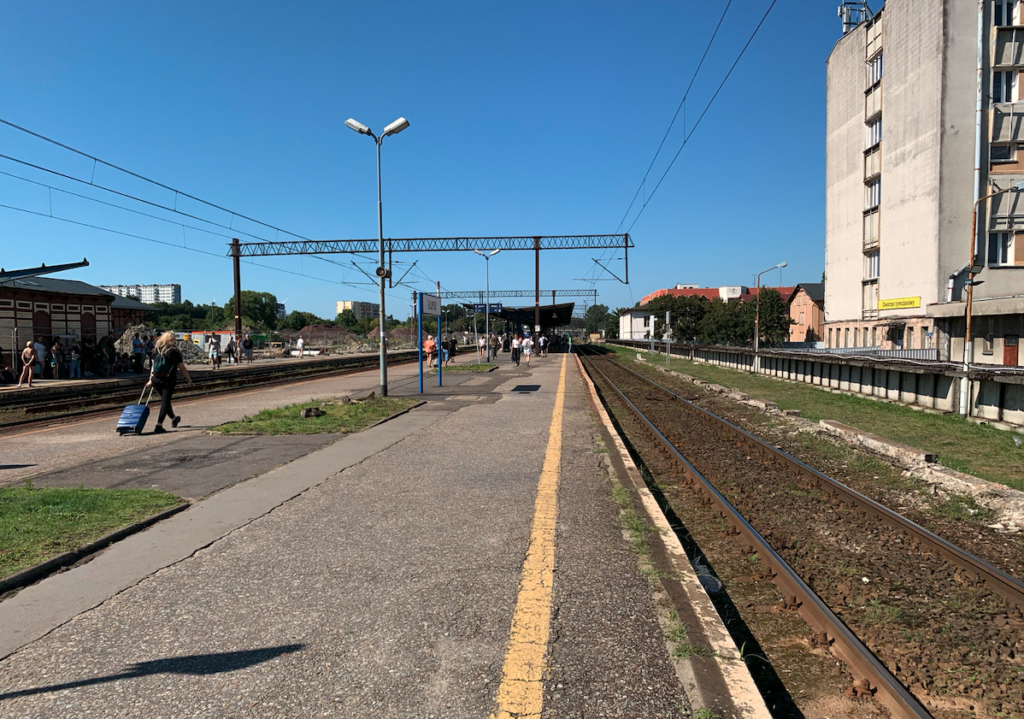
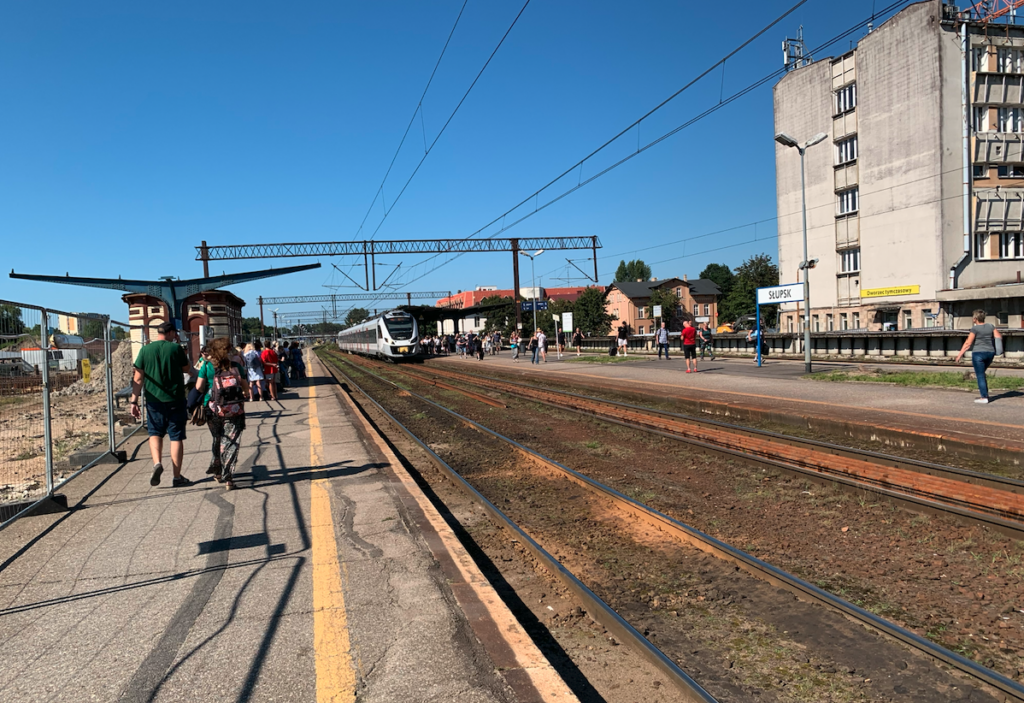
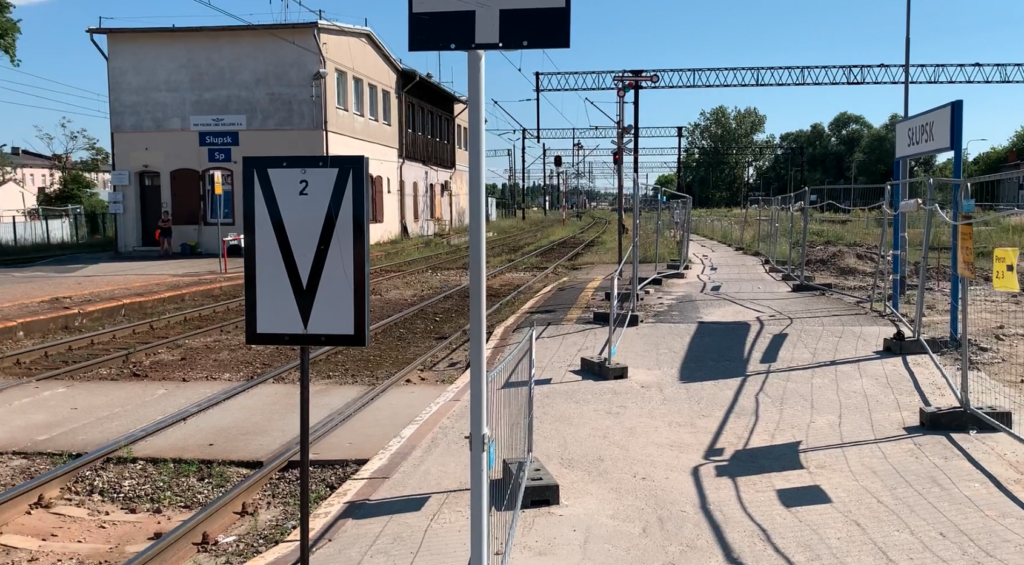
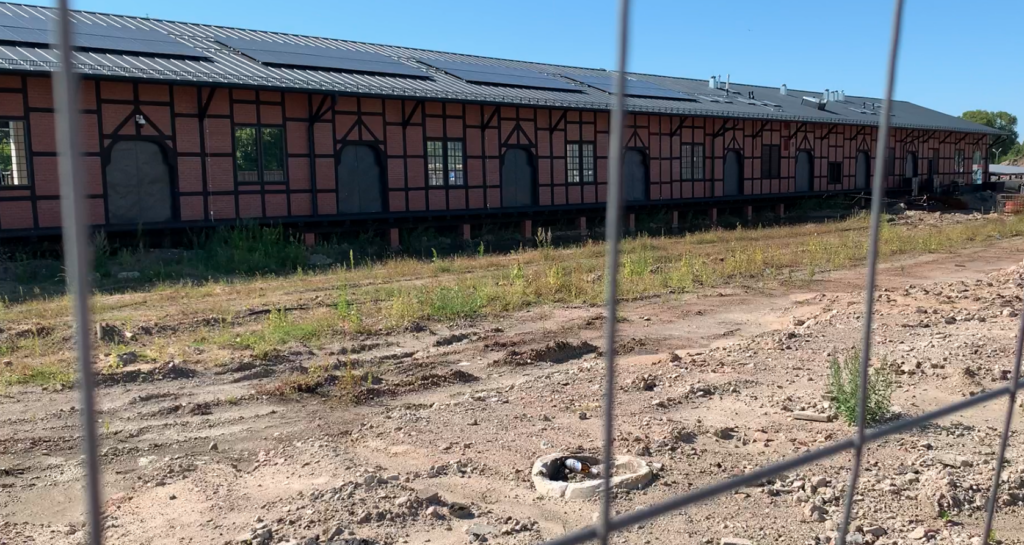
History of Słupsk station.
On July 1, 1869, the first railway connection between the cities of Koszalin and Słupsk was launched. At that time, the station in Słupsk was located among open fields. From the city center to the station, a representative street, Bahnhof Straße (Dworcowa), was brought, which was planted with trees. In 1910, an electric tram was launched to the railway station, along Dworcowa Street (currently Wojska Polskiego Street).
The next railway connections were launched; In September 1870, to Gdańsk. In 1878, to Piła and Ustka. In 1894, to Dębnica Kaszubska (in 1906, the LK was extended to Budowa). There were also narrow-gauge sections to Smołdzino and Cecenowo, which were converted to standard gauge in the period 1913-1933. Słupsk was an important railway junction. The Słupsk-Ustka-Słupsk connection was particularly popular, as it was a commercial and tourist route.
The first temporary station was the so-called “Small Station”, which was located on the premises of the later railway workshops (ZNTK).
In 1869, the station was put into operation, which was a representative facility. It was a three-block building. In the center was a single-storey station hall, which housed ticket and luggage offices, a waiting room and a restaurant for first-class passengers. The central entrance was roofed. Two two-storey wings were added on the sides, where service rooms and apartments for the stationmaster and restaurateur were located. Further buildings were added to the building, where, among other things, a forwarding and telegraph office were placed, and a little later a telephone exchange. The cornices and corners were decorated, which were finished with small, quadrangular turrets. It was a typical Prussian style. The station square had a surface paved with field stones. Places were designated for parking carriages, and a few years later, cars.
Należy pamiętać, że stacja kolejowa w Słupsku miała także tory kolejki wąskotorowej, która obsługiwała lokalne firmy, a także ruch osobowy.
In the 1920s (around 1924) a new locomotive shed was built, which was modelled on the locomotive shed in Piła. The shed had a fan shape, 24 stations and two turntables. In the 1950s, the shed was adapted to service diesel locomotives. The Słupsk locomotive shed partially burned down in the early 21st century and was later dismantled.
In March 1945, the Soviet army entered Słupsk. The “trophy” units dismantled the railway lines to Smołdzino and Budowa, as well as the second track on the current LK Nr 202, on the Słupsk – Lębork section. The Soviets also destroyed the station, which was never rebuilt. On May 27, 1945, PKP launched the first Słupsk–Lębork connection, and in June 1945, trains ran to Ustka, Piła, and Koszalin.
Since the 1960s, there was a footbridge above the station, which could be used to reach the platforms. In the 1980s, due to its technical condition and the small pedestrian flow, the footbridge was dismantled.
In 1975, the District Directorate of State Railways was established in Słupsk, transformed in 1983 into the Railway Transport District, and in 1991 into the Passenger Transport Plant.
In the times of the Polish People’s Republic, the station was for many years served by an unrepresentative building, single-storey, with a basement at 37 Hugo Kołłątaja Street, which still exists today (2024).
It was not until the end of the Polish People’s Republic that construction of a new station began, which was put into service in 1991. The station was characterized by a beautiful elevation, which consisted of eight richly glazed, protruding prisms. The lower floor was clad in sandstone and had two representative entrances, equipped with automatic entrance doors. Additionally, there was a bar, two travel agencies, a bank branch, an ATM. Inside, there was a spacious station hall, with eight ticket offices and a waiting room. Inside, there was also a mezzanine with commercial and service premises. Stairs led to the mezzanine. In the station hall, there were stairs leading to the tunnel and to the platforms. From the platform side, the station elevation was the same, only without service points. On the south side, the station was adjoined by an office building, in which the following operated: the Personnel Education Center, the Post-Secondary School, and the Post-Secondary Medical School. For many years, there were three platforms at the Słupsk passenger station, but Platform 3 was an extension of Platform 2, as a front platform and only served trains departing towards Ustka station. There were 5 platform edges in total, at tracks no. 8, 1, 3, 9, 11. This state lasted until 2022, when renovation began. Access to the platforms and the station building was provided by a passenger tunnel.
The electrification of the Słupsk station took place in 1988. At that time, most of the shape semaphores were replaced with light semaphores, but some of the shape semaphores remained.
Since the 90s of the 20th century, there has been a systematic liquidation of rail connections, rail lines and even stations. This policy also affected the Słupsk junction. A significant part of the station infrastructure was dismantled. In 1997, ZNTK was closed. After 2000, the locomotive shed was taken over by Zakład Taboru in Gdynia, which meant its liquidation. After a few years, their buildings were demolished. In this place, a German hypermarket of the Kaufland chain was built. In 2003, the historic locomotive shed and two water towers were dismantled. Two of the three water towers were dismantled in 2009. The third tower, located near the station itself and the former ZNTK, currently houses a beer bar. In 1999, Zakład Przewozy Pasażerskich was dissolved. In 2008, only the wagon repair workshops on Grunwaldzka Street were operating.
In 2009, when the liquidation of PKP had its next chapter, Warsaw decided to deprive Słupsk of long-distance connections, including with Warsaw and Poznań. Protests by residents and city councilors stopped this process. The situation was saved by Przewozy Regionalne, which in 2007 launched additional trains on the Tri-City – Słupsk route. Although there were breaks and trains did not run on the Lębork – Słupsk section, for example in 2017. In 2015, Koleje Mazowieckie launched a connection on the Warsaw – Słupsk – Ustka route. Unfortunately, this connection is only operated in the summer.
On April 15, 2024, the demolition of the 1991 station began. In August 2024, there was no trace of the station. A new station, better adapted to the current needs of passengers, is to be built in this place. The planned date of opening the new station is 2026.
In 2022, work also began on the reconstruction of the entire track system in Słupsk. This is related, among other things, to the work on laying the second track on LK No. 202. The railway viaduct over Szczecińska Street was completely rebuilt. Słupsk Station is equipped with mechanical rail traffic control devices. The station has four turnout heads controlled from four signal boxes; Sp-1, Sp-3, Sp-4, Sp-5. In connection with the reconstruction of the station, a Local Control Center will be created here. The narrow-gauge tracks of the unused narrow-gauge railway in the northern part of the city were dismantled as a result of the commencement of construction of the “Three Waves – Słupsk” water park.
In August 2024, 73 passenger trains departed from Słupsk station and you could reach: Białystok, Bielsko-Biała Główna, Bydgoszcz Główna, Chojnice, Darłowo, Elbląg, Gdańsk Główny, Gdynia Główna, Katowice, Kołobrzeg, Koszalin, Kraków Główny, Lębork, Lublin Główny, Łódź Fabryczna, Miastko, Olsztyn Główny, Poznań Główny, Przemyśl Główny, Szczecin Główny, Szczecinek, Tczew, Ustka, Ustka Uroczysko, Warszawa Zachodnia, Wrocław Główny.
Modernization works at the Słupsk railway junction.
In April 2024, it was reported that; The cost of all railway investments in the Słupsk junction and on the Lębork – Słupsk section (47 km) was estimated at PLN 1.8 billion. Works at the Słupsk station and on the LK No. 202 Słupsk – Lębork section are one of the largest investments of PLK S.A. in the Pomeranian Voivodeship. At the Słupsk station, the entire platforms will be rebuilt. The reconstruction also includes an underground passage, from which elevators will lead to each platform, which will facilitate access to the railway for people with limited mobility and travelers with bicycles or larger luggage. A modern passenger information system will be installed, which will facilitate orientation at the station, and the displays will inform about train arrivals and departures. Construction of a new signal box building for the Słupsk local control center has begun. The works will also include the reconstruction of the bridge on the Słupia River and 3 railway viaducts in the city.
The works are associated with restrictions on vehicular and pedestrian traffic. Drivers must use detours. A temporary pedestrian crossing has been opened from the side of Maria Konopnicka Street, at the level of the railway tracks. Trains there are limited to 20 km/h. This crossing can be used to reach the new bus station at Towarowa Street.
In March 2024, the Temporary Station located in a former office building with an entrance from the west side began operating. On the ground floor of the building there is a waiting room, ticket offices and toilets. The entire facility is accessible to people with limited mobility. The road to the temporary station and to the renovated platforms has been marked with special boards in yellow and black.
The changes in Słupsk concern not only the railway system, but also bus transport. For many years, a bus station operated at 15 Hugona Kołłątaja Street. The station had as many as 18 platform positions for buses. The city authorities decided to build a new station, which was located closer to the train station. The areas on the western side of the train station were designated for the construction of the new bus station. These areas were railway lands, but no longer used by PKP. The station was built on Torowa Street, within a dozen or so months and was put into operation in 2022. The station building used elements of the architecture of a former railway warehouse. The warehouse was not listed as a historical monument, but its half-timbered walls had their charm. Relocating the bus station significantly relieved the congested city center, and the new road layout, on the western side of the train station, favors more efficient bus communication.
New station.
The new station will be a building that is to symbolize the gate to the city. The elevation will have diagonal divisions, which will be finished with brick-colored ceramic tiles. Some tiles will be matte, and others will be glossy. The lighting distributed in the elevation will be complemented. Inside, the northern side of the building will be intended for passenger service. The entrance to it will be from a transitional passage. The station hall will have two floors connected by stairs and an elevator. The internal colors will be white and gray, complemented by ash-colored strips. The hall ceilings will be made of wood. On the first floor there will be commercial premises. On the second floor there will be: ticket offices, toilets, a waiting room with a small corner for children. In the southern part there will be commercial and catering premises. The third floor of the station will be occupied by the Railway Protection Guard. The PKP logo and the words Dworzec Kolejowy will be placed on the roof of the station, and the words Dworzec Słupsk will be placed on the opposite side. Railway information will be provided in the form of electronic displays. There will also be display cases with paper information on train departures and arrivals. There will be benches with sockets for charging mobile phones.
A city square with alleys, greenery and small architecture will be created on the station square. It will be tilted towards the station passage. There will be a bicycle shelter for 30 bicycles for bicycles. A parking lot for about 70 cars will also be built, with several spaces for disabled people and charging stations for electric cars. There will be bus stops, a taxi rank and a kiss&ride bay at the station square.
The office building located nearby will also be rebuilt. It will be insulated and its appearance will change. In the lower part, the elevation will refer to the color of the new station, while on the upper floors it will be finished with matte and shiny white ceramic tiles.
The total cost of the investment is PLN 55.5 million. The investor is the Polish State Railways S.A. The contractor for the construction works is Budimex S.A., and the design for the construction of the new station was developed by the Studium Sp. z o.o. studio.
New platforms.
The entire station plain will be changed. Three new island platforms and 6-platform edges will be built. Platform 3 will be intended for trains starting and ending the run in Słupsk. The platforms will be higher with edges made of prefabricated slabs with yellow warning lines and guide paths and with buttons for the blind and visually impaired. The remaining platform surface will be made of paving stones. There will be new shelters, benches and small architecture on the platforms. A modern passenger information system will be installed. The historic pavilions will be restored. The old, pre-war, cast iron, riveted shelter supports will also remain. Access to the platforms, train station and bus station will be provided by a rebuilt tunnel. Passengers will have access to stairs and lifts. As part of the investment, 40 km of tracks will be replaced. The reconstruction of the station in Słupsk is being carried out by Torpol, and LK Nr 202 by Intercor.
Written by Karol Placha Hetman
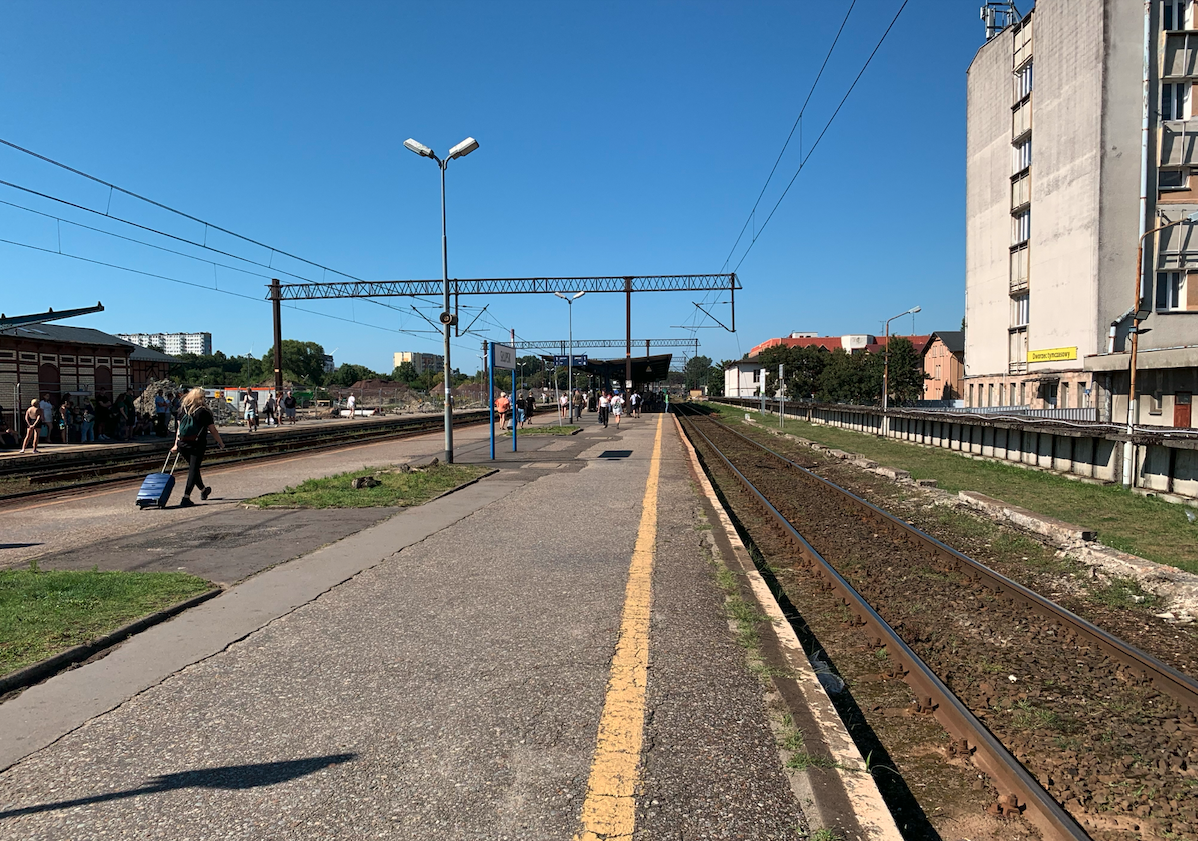
Leave a Reply
You must be logged in to post a comment.